Techno-Economic Assessment of Half-Cell Modules for Desert Climates: An Overview on Power, Performance, Durability and Costs
Abstract
:1. Introduction
2. Technical Assessment
2.1. Increased Optical Gains and Reduced Electrical Losses
2.2. Effect of Spacing in Module Level
2.3. Optimized Tab Width
2.4. Cell-to-Module Power Ratio and Increased Yield
2.5. Interconnection Design and Manufacturing Feasibility
2.6. Durability and Fatigue of Interconnecting Tabs
2.7. Performance
2.7.1. Thermal Performance
2.7.2. Partial Shading and Soiling Challenge
3. Economic Assessment
3.1. Large-Size Wafers
3.2. Cell-Cutting Costs
3.3. Module Costs and System Benefits
4. Discussion
5. Summary and Conclusions
Funding
Informed Consent Statement
Acknowledgments
Conflicts of Interest
References
- Komoto, K.; Xu, H.; Lv, F.; Wang, S.; Sinha, P.; Cunow, E.; Wade, A.; Faiman, D.; Araki, K.; Perez, M.; et al. Energy from the Desert: Very Large Scale PV Power Plants for Shifting to Renewable Energy Future; Report IEA-PVPS T8-01:2015; International Energy Agency: Paris, France, 2015. [Google Scholar]
- Global Solar Atlas. Available online: https://globalsolaratlas.info/map (accessed on 14 March 2021).
- We Could Power The Entire World By Harnessing Solar Energy From 1% Of The Sahara. Available online: https://www.forbes.com/sites/quora/2016/09/22/we-could-power-the-entire-world-by-harnessing-solar-energy-from-1-of-the-sahara/?sh=1838c43d4406 (accessed on 14 March 2021).
- Hanifi, H.; Jaeckel, B.; Schneider, J. Simulation of Optical and Electrical Losses of PV Modules in Moderate and Desert Conditions. In Proceedings of the 2019 IEEE 46th Photovoltaic Specialists Conference (PVSC), Chicago, IL, USA, 16–21 June 2019; pp. 1255–1259. [Google Scholar] [CrossRef]
- Schlothauer, J.; Jungwirth, S.; Köhl, M.; Röder, B. Degradation of the encapsulant polymer in outdoor weathered photovoltaic modules: Spatially resolved inspection of EVA ageing by fluorescence and correlation to electroluminescence. Sol. Energy Mater. Sol. Cells 2012, 102, 75–85. [Google Scholar] [CrossRef]
- Czanderna, A.W.; Pern, F.J. Encapsulation of PV modules using ethylene vinyl acetate copolymer as a pottant: A critical review. Sol. Energy Mater. Sol. Cells 1996, 43, 101–181. [Google Scholar] [CrossRef]
- Osterwald, C.R.; Benner, J.P.; Pruett, J.; Anderberg, A.; Rummel, S.; Ottoson, L. Degradation in weathered crystalline-silicon PV modules apparently caused by UV radiation. In Proceedings of the 3rd World Conference on Photovoltaic Energy Conversion, Osaka, Japan, 11–18 May 2003; Volume C. [Google Scholar]
- Hanifi, H.; Pander, M.; Zeller, U.; Ilse, K.; Dassler, D.; Mirza, M.; Bahattab, M.A.; Jaeckel, B.; Hagendorf, C.; Ebert, M.; et al. Loss analysis and optimization of PV module components and design to achieve higher energy yield and longer service life in desert regions. Appl. Energy 2020, 280, 116028. [Google Scholar] [CrossRef]
- Bouraiou, A.; Hamouda, M.; Chaker, A.; Neçaibia, A.; Mostefaoui, M.; Boutasseta, N.; Ziane, A.; Dabou, R.; Sahouane, N.; Lachtar, S. Experimental investigation of observed defects in crystalline silicon PV modules under outdoor hot dry climatic conditions in Algeria. Sol. Energy 2018, 159, 475–487. [Google Scholar] [CrossRef]
- Cabrera-Tobar, A.; Fernández, Y.F.; Huaca, J.; Pozo, M.; Bellmunt, O.G.; Pavan, A.M. The effect of ambient temperature on the yield of a 3 MWp PV plant installed in Ecuador. In Proceedings of the 2019 IEEE International Conference on Environment and Electrical Engineering and 2019 IEEE Industrial and Commercial Power Systems Europe, Genova, Italy, 11–14 June 2019. [Google Scholar] [CrossRef]
- Kawajiri, K.; Oozeki, T.; Genchi, Y. Effect of Temperature on PV Potential in the World. Environ. Sci. Technol. 2011, 45, 9030–9035. [Google Scholar] [CrossRef]
- Skoplaki, E.; Palyvos, J.A. On the temperature dependence of photovoltaic module electrical performance: A review of efficiency/power correlations. Sol. Energy 2009, 83, 614–624. [Google Scholar] [CrossRef]
- Dubey, S.; Sarvaiya, J.N.; Seshadri, B. Temperature Dependent Photovoltaic (PV) Efficiency and Its Effect on PV Production in the World-A Review. Energy Procedia 2013, 33, 311–321. [Google Scholar] [CrossRef] [Green Version]
- Regondi, S.; Hanifi, H.; Schneider, J. Modeling and Simulation of the Influence of Interconnection Losses on Module Temperature in Moderate and Desert Regions. IEEE J. Photovolt. 2019, 9, 1449–1455. [Google Scholar] [CrossRef]
- Hanifi, H.; Regondi, S.; Jaeckel, B.; Schneider, J. Determination of electrical characteristics and temperature of PV modules by means of a coupled electrical-thermal model. J. Renew. Sustain. Energy 2020, 12, 023501. [Google Scholar] [CrossRef]
- Meier, R.; Pander, M.; Großer, S.; Dietrich, S. Microstructural Optimization Approach of Solar Cell Interconnectors Fatigue Behavior for Enhanced Module Lifetime in Extreme Climates. Energy Procedia 2016, 92, 560–568. [Google Scholar] [CrossRef]
- Aly, S.P.; Ahzi, S.; Barth, N.; Abdallah, A. Numerical analysis of the reliability of photovoltaic modules based on the fatigue life of the copper interconnects. Sol. Energy 2020, 212, 152–168. [Google Scholar] [CrossRef]
- Pander, M.; Dietrich, S.; Meier, R.; Ebert, M. Fatigue Analysis of Solar Cell Interconnectors due to Cyclic Mechanical Loading. In Proceedings of the 32nd European Photovoltaic Solar Energy Conference and Exhibition, Munich, Germany, 20–24 June 2016; pp. 1589–1597. [Google Scholar] [CrossRef]
- Cordero, R.R.; Damiani, A.; Laroze, D.; MacDonell, S.; Jorquera, J.; Sepúlveda, E.; Feron, S.; Llanillo, P.; Labbe, F.; Carrasco, J.; et al. Effects of soiling on photovoltaic (PV) modules in the Atacama Desert. Sci. Rep. 2018, 8, 13943. [Google Scholar] [CrossRef] [PubMed] [Green Version]
- Darwish, Z.A.; Kazem, H.A.; Sopian, K.; Al-Goul, M.; Alawadhi, H. Effect of dust pollutant type on photovoltaic performance. Renew. Sustain. Energy Rev. 2014, 41, 735–744. [Google Scholar] [CrossRef]
- Mekhilef, S.; Saidur, R.; Kamalisarvestani, M. Effect of dust, humidity and air velocity on efficiency of photovoltaic cells. Renew. Sustain. Energy Rev. 2012, 16, 2920–2925. [Google Scholar] [CrossRef]
- El-Nashar, A.M. Seasonal effect of dust deposition on a field of evacuated tube collectors on the performance of a solar desalination plant. Desalination 2009, 239, 66–81. [Google Scholar] [CrossRef]
- Asl-Soleimani, E.; Farhangi, S.; Zabihi, M. The effect of tilt angle, air pollution on performance of photovoltaic systems in Tehran. Renew. Energy 2001, 24, 459–468. [Google Scholar] [CrossRef]
- Sarver, T.; Al-Qaraghuli, A.; Kazmerski, L.L. A comprehensive review of the impact of dust on the use of solar energy: History, investigations, results, literature, and mitigation approaches. Renew. Sustain. Energy Rev. 2013, 22, 698–733. [Google Scholar] [CrossRef]
- Mejia, F.A.; Kleissl, J. Soiling losses for solar photovoltaic systems in California. Sol. Energy 2013, 95, 357–363. [Google Scholar] [CrossRef] [Green Version]
- Jiang, H.; Lu, L.; Sun, K. Experimental investigation of the impact of airborne dust deposition on the performance of solar photovoltaic (PV) modules. Atmos. Environ. 2011, 45, 4299–4304. [Google Scholar] [CrossRef]
- El-Nashar, A.M. Effect of dust deposition on the performance of a solar desalination plant operating in an arid desert area. Sol. Energy 2003, 75, 421–431. [Google Scholar] [CrossRef]
- Cuddihy, E.F. Theoretical considerations of soil retention. Sol. Energy Mater. 1980, 3, 21–33. [Google Scholar] [CrossRef]
- Al-Hasan, A.Y.; Ghoneim, A.A. A new correlation between photovoltaic panel’s efficiency and amount of sand dust accumulated on their surface. Int. J. Sustain. Energy 2005, 24, 187–197. [Google Scholar] [CrossRef]
- Dhaouadi, R.; Al-Othman, A.; Aidan, A.A.; Tawalbeh, M.; Zannerni, R. A characterization study for the properties of dust particles collected on photovoltaic (PV) panels in Sharjah, United Arab Emirates. Renew. Energy 2021, 171, 133–140. [Google Scholar] [CrossRef]
- Maghami, M.R.; Hizam, H.; Gomes, C.; Radzi, M.A.; Rezadad, M.I.; Hajighorbani, S. Power loss due to soiling on solar panel: A review. Renew. Sustain. Energy Rev. 2016, 59, 1307–1316. [Google Scholar] [CrossRef] [Green Version]
- Mani, M.; Pillai, R. Impact of dust on solar photovoltaic (PV) performance: Research status, challenges and recommendations. Renew. Sustain. Energy Rev. 2010, 14, 3124–3131. [Google Scholar] [CrossRef]
- Ilse, K.K.; Figgis, B.W.; Naumann, V.; Hagendorf, C.; Bagdahn, J. Fundamentals of soiling processes on photovoltaic modules. Renew. Sustain. Energy Rev. 2018, 98, 239–254. [Google Scholar] [CrossRef]
- Ilse, K.; Micheli, L.; Figgis, B.W.; Lange, K.; Daßler, D.; Hanifi, H.; Wolfertstetter, F.; Naumann, V.; Hagendorf, C.; Gottschalg, R.; et al. Techno-Economic Assessment of Soiling Losses and Mitigation Strategies for Solar Power Generation. Joule 2019, 3, 2303–2321. [Google Scholar] [CrossRef] [Green Version]
- International Finance Corporation. Utility-Scale Solar Photovoltaic Power Plants. Available online: https://www.ifc.org/wps/wcm/connect/a1b3dbd3-983e-4ee3-a67b-cdc29ef900cb/IFC+Solar+Report_Web+_08+05.pdf?MOD=AJPERES&CVID=kZePDPG (accessed on 25 March 2021).
- International Technology Roadmap for Photovoltaics ITRPV—The Mechanical Engineering Industry Association VDMA. International Technology Roadmap for Photovoltaics Report 2019. Available online: https://itrpv.vdma.org/ (accessed on 15 March 2021).
- Bouaichi, A.; Merrouni, A.A.; Hajjaj, C.; Zitouni, H.; Ghennioui, A.; El Amrani, A.; Messaoudi, C. In-situ inspection and measurement of degradation mechanisms for crystalline and thin film PV systems under harsh climatic conditions. Energy Procedia 2019, 157, 1210–1219. [Google Scholar] [CrossRef]
- Bosco, N.; Silverman, T.; Wohlgemuth, J.; Kurtz, S.; Inoue, M.; Sakurai, K.; Shioda, T.; Zenkoh, H.; Miyashita, M.; Tadanori, T.; et al. Accelerating Fatigue Testing for Cu Ribbon Interconnects Espec 2013 Photovoltaic Module Reliability Workshop; NREL/TP-5200-60167; National Renewable Energy Laboratory: Golden, CO, USA, 2013. Available online: https://digital.library.unt.edu/ark:/67531/metadc828825/ (accessed on 22 March 2021).
- de Oliveira, M.C.C.; Cardoso, A.S.A.D.; Viana, M.M.; Lins, V.D.F.C. The causes and effects of degradation of encapsulant ethylene vinyl acetate copolymer (EVA) in crystalline silicon photovoltaic modules: A review. Renew. Sustain. Energy Rev. 2018, 81, 2299–2317. [Google Scholar] [CrossRef]
- Meena, R.; Kumar, S.; Gupta, R. Comparative investigation and analysis of delaminated and discolored encapsulant degradation in crystalline silicon photovoltaic modules. Sol. Energy 2020, 203, 114–122. [Google Scholar] [CrossRef]
- Toth, S.; Muller, M.; Miller, D.C.; Moutinho, H.; To, B.; Micheli, L.; Linger, J.; Engtrakul, C.; Einhorn, A.; Simpson, L. Soiling and cleaning: Initial observations from 5-year photovoltaic glass coating durability study. Sol. Energy Mater. Sol. Cells 2018, 185, 375–384. [Google Scholar] [CrossRef]
- Miller, D.C.; Alnuaimi, A.; John, J.J.; Simpson, L.J.; Engtrakul, C.; Einhorn, A.; Lanaghan, C.L.; Newkirk, J.M.; To, B.; Holsapple, D.; et al. The Abrasion of Photovoltaic Glass: A Comparison of the Effects of Natural and Artificial Aging. IEEE J. Photovoltaics 2019, 10, 173–180. [Google Scholar] [CrossRef]
- Asset Management Best Practice Guidelines/Version 1.0 2019. Available online: https://www.solarpowereurope.org (accessed on 13 June 2021).
- The Power to Change: Solar and Wind Cost Reduction Potential to 2025. 2016. Available online: https://www.irena.org/publications/2016/Jun/The-Power-to-Change-Solar-and-Wind-Cost-Reduction-Potential-to-2025 (accessed on 13 June 2021).
- Renewable Power Generation Costs in 2020. Available online: https://www.irena.org/publications/2020/Jun/Renewable-Power-Costs-in-2019 (accessed on 13 June 2021).
- Schneider, J.; Hanifi, H.; Dassler, D.; Pander, M.; Kaule, F.; Turek, M. Half-Cell Solar Modules: The New Standard in PV Production? 2019. Available online: https://www.pv-tech.org/technical-papers/halfcell-solar-modules-the-new-standard-in-pv-production/ (accessed on 30 March 2021).
- International Technology Roadmap for Photovoltaics ITRPV—The Mechanical Engineering Industry Association VDMA, International Technology Roadmap for Photovoltaics report of 2021. Available online: https://itrpv.vdma.org/en/ (accessed on 30 March 2021).
- Luque, A.; Hegedus, S. Handbook of Photovoltaic Science and Engineering; John Wiley & Sons: Chichester, UK, 2010. [Google Scholar] [CrossRef]
- Hanifi, H.; Dassler, D.; Schneider, J.; Turek, M.; Schindler, S.; Bagdahn, J. Optimized Tab Width in Half-cell Modules. Energy Procedia 2016, 92, 52–59. [Google Scholar] [CrossRef]
- Guo, S.; Schneider, J.; Lu, F.; Hanifi, H.; Turek, M.; Dyrba, M.; Peters, I.M. Investigation of the short-circuit current increase for PV modules using halved silicon wafer solar cells. Sol. Energy Mater. Sol. Cells 2015, 133, 240–247. [Google Scholar] [CrossRef]
- Guo, S.; Singh, J.P.; Peters, I.M.; Aberle, A.G.; Walsh, T.M. A Quantitative Analysis of Photovoltaic Modules Using Halved Cells. Int. J. Photoenergy 2013, 2013, 1–8. [Google Scholar] [CrossRef]
- Muller, J.; Hinken, D.; Blankemeyer, S.; Kohlenberg, H.; Sonntag, U.; Bothe, K.; Dullweber, T.; Kontges, M.; Brendel, R. Resistive Power Loss Analysis of PV Modules Made from Halved 15.6 × 15.6 cm2 Silicon PERC Solar Cells with Efficiencies up to 20.0%. IEEE J. Photovolt. 2014, 5, 189–194. [Google Scholar] [CrossRef]
- Kim, N.; Lee, S.; Zhao, X.G.; Kim, D.; Oh, C.; Kang, H. Reflection and durability study of different types of backsheets and their impact on c-Si PV module performance. Sol. Energy Mater. Sol. Cells 2016, 146, 91–98. [Google Scholar] [CrossRef]
- Saw, M.H.; Khoo, Y.S.; Singh, J.P.; Wang, Y. Cell-to-module optical loss/gain analysis for various photovoltaic module materials through systematic characterization. Jpn. J. Appl. Phys. 2017, 56, 08MD03. [Google Scholar] [CrossRef]
- Hanifi, H.; Schneider, J.; Bagdahn, J. Reduced Shading Effect on Half-Cell Modules—Measurement and Simulation. In Proceedings of the 31st European Photovoltaic Solar Energy Conference and Exhibition, Hamburg, Germany, 14–18 September 2015; pp. 2529–2533. [Google Scholar] [CrossRef]
- Eiternick, S.; Kaufmann, K.; Schneider, J.; Turek, M. Loss Analysis for Laser Separated Solar Cells. Energy Procedia 2014, 55, 326–330. [Google Scholar] [CrossRef]
- Xia, L.; Chen, J.; Liao, K.; Huang, L.; Li, Q.; Luo, X. Influence of laser cutting conditions on electrical characteristics of half-size bifacial silicon solar cells. Mater. Sci. Semicond. Process. 2019, 105, 104747. [Google Scholar] [CrossRef]
- Hanifi, H.; Dassler, D.; Turek, M.; Schneider, J. Evaluation and Comparison of PV Modules With Different Designs of Partial Cells in Desert and Moderate Climates. IEEE J. Photovolt. 2018, 8, 1266–1273. [Google Scholar] [CrossRef]
- Eiternick, S.; Kaule, F.; Zühlke, H.-U.; Kießling, T.; Grimm, M.; Schoenfelder, S.; Turek, M. High Quality Half-cell Processing Using Thermal Laser Separation. Energy Procedia 2015, 77, 340–345. [Google Scholar] [CrossRef]
- Kaule, F.; Pander, M.; Turek, M.; Grimm, M.; Hofmueller, E.; Schoenfelder, S. Mechanical damage of half-cell cutting technologies in solar cells and module laminates. AIP Conf. Proc. 2018, 1999, 020013. [Google Scholar] [CrossRef]
- IEC 61370-1: Photovoltaic (PV) Module Safety Qualification-Part 1: Requirements for Construction 2016. Available online: https://webstore.iec.ch/publication/25674 (accessed on 15 April 2021).
- Haedrich, I.; Eitner, U.; Wiese, M.; Wirth, H. Unified methodology for determining CTM ratios: Systematic prediction of module power. Sol. Energy Mater. Sol. Cells 2014, 131, 14–23. [Google Scholar] [CrossRef]
- Dupré, O.; Levrat, J.; Champliaud, J.; Despeisse, M.; Boccard, M.; Ballif, C. Reassessment of cell to module gains and losses: Accounting for the current boost specific to cells located on the edges. AIP Conf. Proc. 2018, 1999, 090001. [Google Scholar] [CrossRef]
- Hanifi, H.; Pfau, C.; Dassler, D.; Schindler, S.; Schneider, J.; Turek, M.; Bagdahn, J. Investigation of cell-to-module (CTM) ratios of PV modules by analysis of loss and gain mechanisms-PV Tech. Photovolt. Int. 2016, 32, 90–98. Available online: https://www.pv-tech.org/technical-papers/investigation-of-celltomodule-ctm-ratios-of-pv-modules-by-analysis-of-loss-and-gain-mechanisms/ (accessed on 9 May 2021).
- Mittag, M.; Pfreundt, A.; Shahid, J.; Wöhrle, N.; Neuhaus, D.H. Techno-Economic Analysis of Half-Cell Modules—The Impact of Half-Cells on Module Power and Costs. In Proceedings of the 36th European Photovoltaic Solar Energy Conference and Exhibition, Marseille, France, 9–13 September 2019; pp. 1032–1039. [Google Scholar] [CrossRef]
- Hanifi, H.; Khan, M.Z.; Jaeckel, B.; Hagendorf, C.; Schneider, J.; Abdallah, A.; Ilse, K. Optimum PV module interconnection layout and mounting orientation to reduce inhomogeneous soiling losses in desert environments. Sol. Energy 2020, 203, 267–274. [Google Scholar] [CrossRef]
- Herrmann, W.; Bogdanski, N. Outdoor weathering of PV modules—Effects of various climates and comparison with accelerated laboratory testing. In Proceedings of the 37th IEEE Photovoltaic Specialists Conference, Seattle, WA, USA, 19–24 June 2011; pp. 002305–002311. [Google Scholar] [CrossRef]
- IEC 61215-2: Terrestrial Photovoltaic (PV) Modules—Design Qualification and Type Approval-Part 2: Test Procedures. Available online: https://webstore.iec.ch/publication/61350 (accessed on 19 May 2021).
- Pander, M.; Meier, R.; Sander, M.; Dietrich, S.; Ebert, M. Lifetime Estimation for Solar Cell Interconnectors. In Proceedings of the 28th European Photovoltaic Solar Energy Conference and Exhibition, Paris, France, 30 September–4 October 2013; pp. 2851–2857. [Google Scholar] [CrossRef]
- Malik, S.; Dassler, D.; Froebel, J.; Schneider, J.; Ebert, M. Outdoor Data Evaluation of Half-/Full-Cell Modules with Regard to Measurement Uncertainties and the Application of Statistical Methods. In Proceedings of the 29th European Photovoltaic Solar Energy Conference and Exhibition, Amsterdam, The Netherlands, 23–25 September 2014; pp. 3269–3273. [Google Scholar] [CrossRef]
- Isbilir, K.; Lisco, F.; Womack, G.; Abbas, A.; Walls, J.M. Testing of an Anti-Soiling Coating for PV Module Cover Glass. In Proceedings of the 2018 IEEE 7th World Conference on Photovoltaic Energy Conversion (WCPEC) (A Joint Conference of 45th IEEE PVSC, 28th PVSEC & 34th EU PVSEC), Waikoloa, HI, USA, 10–15 June 2018; pp. 3426–3431. [Google Scholar] [CrossRef] [Green Version]
- Huang, Z.-S.; Shen, C.; Fan, L.; Ye, X.; Shi, X.; Li, H.; Zhang, Y.; Lai, Y.; Quan, Y.-Y. Experimental investigation of the anti-soiling performances of different wettability of transparent coatings: Superhydrophilic, hydrophilic, hydrophobic and superhydrophobic coatings. Sol. Energy Mater. Sol. Cells 2021, 225, 111053. [Google Scholar] [CrossRef]
- Ilse, K.K.; Figgis, B.W.; Werner, M.; Naumann, V.; Hagendorf, C.; Pöllmann, H.; Bagdahn, J. Comprehensive analysis of soiling and cementation processes on PV modules in Qatar. Sol. Energy Mater. Sol. Cells 2018, 186, 309–323. [Google Scholar] [CrossRef]
- Simsek, E.; Williams, M.J.; Pilon, L. Effect of dew and rain on photovoltaic solar cell performances. Sol. Energy Mater. Sol. Cells 2020, 222, 110908. [Google Scholar] [CrossRef]
- de Jesus, M.A.M.L.; Timò, G.; Agustín-Sáenz, C.; Braceras, I.; Cornelli, M.; de Mello Ferreira, A. Anti-soiling coatings for solar cell cover glass: Climate and surface properties influence. Sol. Energy Mater. Sol. Cells 2018, 185, 517–523. [Google Scholar] [CrossRef]
- Hanifi, H.; Pander, M.; Jaeckel, B.; Schneider, J.; Bakhtiari, A.; Maier, W. A novel electrical approach to protect PV modules under various partial shading situations. Sol. Energy 2019, 193, 814–819. [Google Scholar] [CrossRef]
- Schill, C.; Brachmann, S.; Koehl, M. Impact of soiling on IV-curves and efficiency of PV-modules. Sol. Energy 2015, 112, 259–262. [Google Scholar] [CrossRef]
- Gostein, M.; Duster, T.; Thuman, C. Accurately measuring PV soiling losses with soiling station employing module power measurements. In Proceedings of the 2015 IEEE 42nd Photovoltaic Specialist Conference, New Orleans, LA, USA, 14–19 June 2015; pp. 1–4. [Google Scholar] [CrossRef]
- Cui, Y.-Q.; Xiao, J.-H.; Xiang, J.-L.; Sun, J.-H. Characterization of Soiling Bands on the Bottom Edges of PV Modules. Front. Energy Res. 2021, 9, 665411. [Google Scholar] [CrossRef]
- Lu, F.; Guo, S.; Walsh, T.M.; Aberle, A.G. Improved PV Module Performance under Partial Shading Conditions. Energy Procedia 2013, 33, 248–255. [Google Scholar] [CrossRef] [Green Version]
- Mittag, M.; Pfeundt, A.; Shahid, J. Impact of Solar Cell Dimensions on Module Power, Efficiency and Cell-To-Module Losses. In Proceedings of the 30th PV Solar Energy Conference (PVSEC-30), Jeju, Korea, 13 November 2020; pp. 1–6. [Google Scholar]
- TaiyangNews Webinar on PV Industry Trends to Design Modules with Higher Power Ratings Taiyang News. 2019. Available online: http://taiyangnews.info/webinars/Nov-18-Larger-Wafer-Based-Solar-Module/ (accessed on 21 March 2021).
- Sylvia, T. Manufacturers Call for Module Size Standardization-Pv Magazine International. PV Magazine. 2021. Available online: https://www.pv-magazine.com/2021/01/05/Manufacturers-Call-for-Module-Size-Standardization/ (accessed on 21 March 2021).
- Bhambhani, A. LONGi Stops Mass Production Of M2 Wafer Size|TaiyangNews. Taiyang News. 2020. Available online: http://taiyangnews.info/technology/Longi-Stops-Mass-Production-of-m2-Wafer-Size/ (accessed on 21 March 2021).
- Largest Wafer Offers Lowest LCOE, Finds DNV GL-Pv Magazine International. Available online: https://www.pv-magazine.com/2020/12/04/Largest-Wafer-Offers-Lowest-Lcoe-Finds-Dnv-Gl/ (accessed on 30 May 2021).
- AE Solar Launches New Solar Module Series, Increases Warranties-Pv Magazine International. Available online: https://www.pv-magazine.com/2022/03/02/AE-Solar-Launches-New-Solar-Module-Series-Increases-Warranties/ (accessed on 22 April 2022).
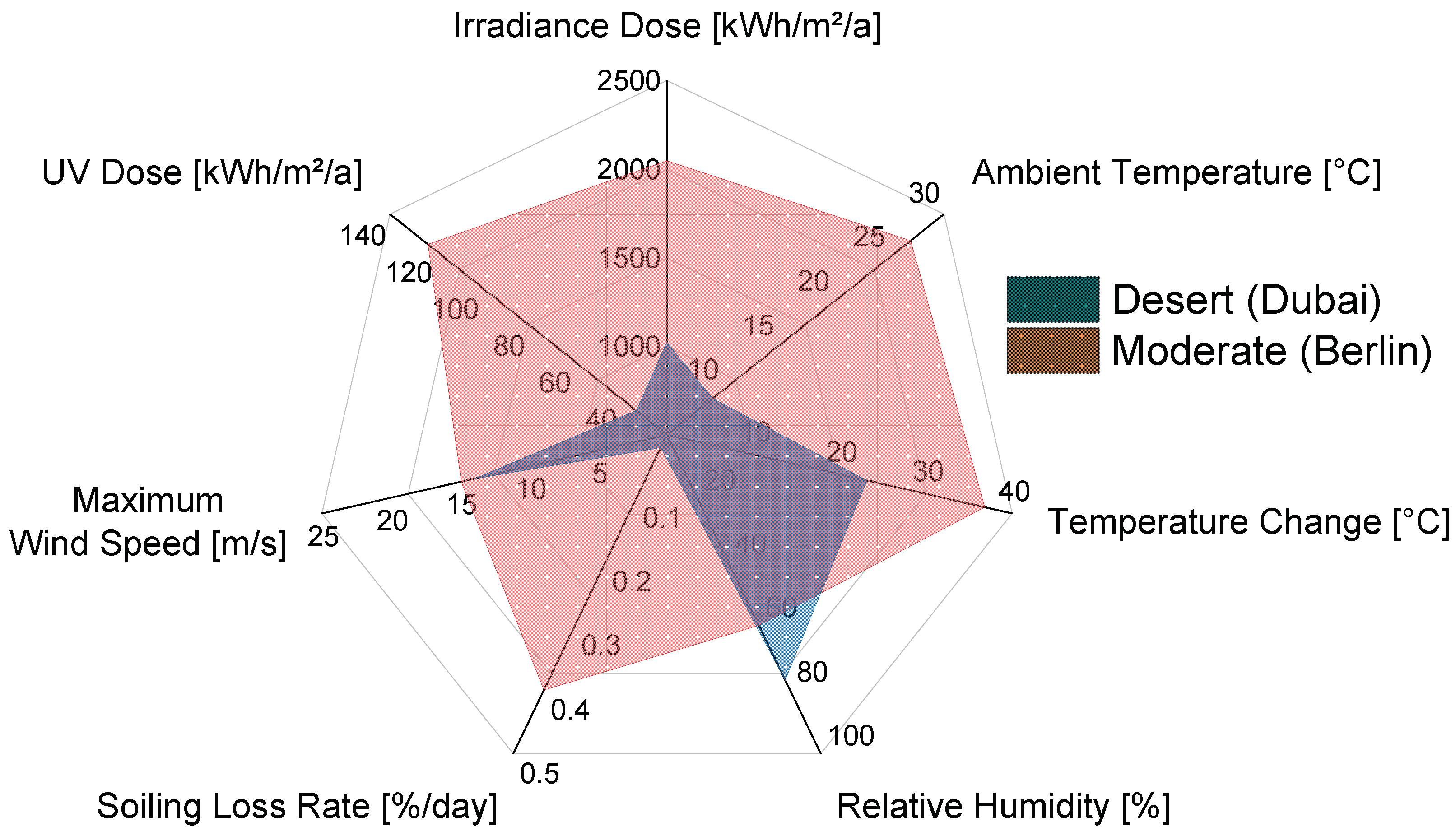

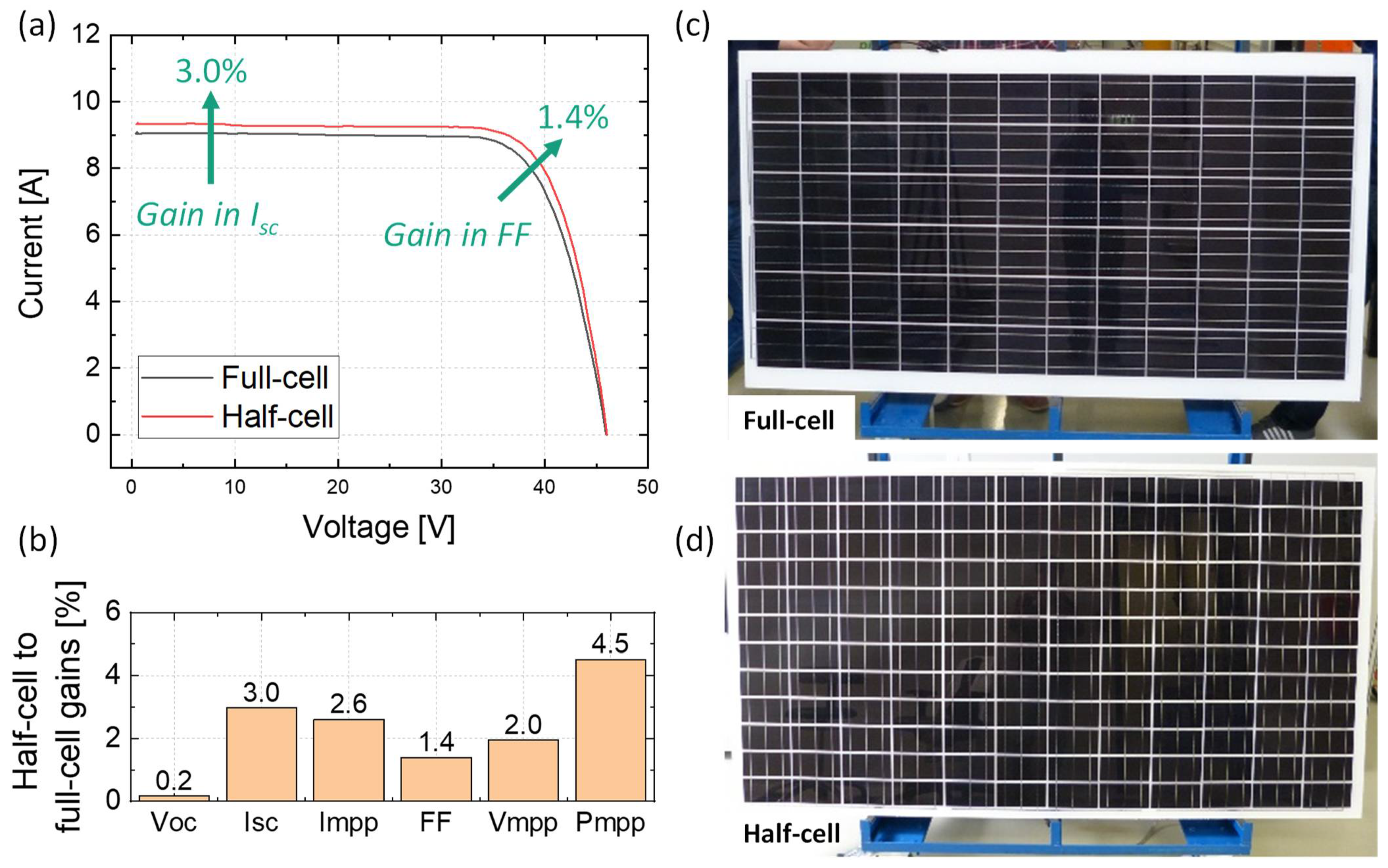
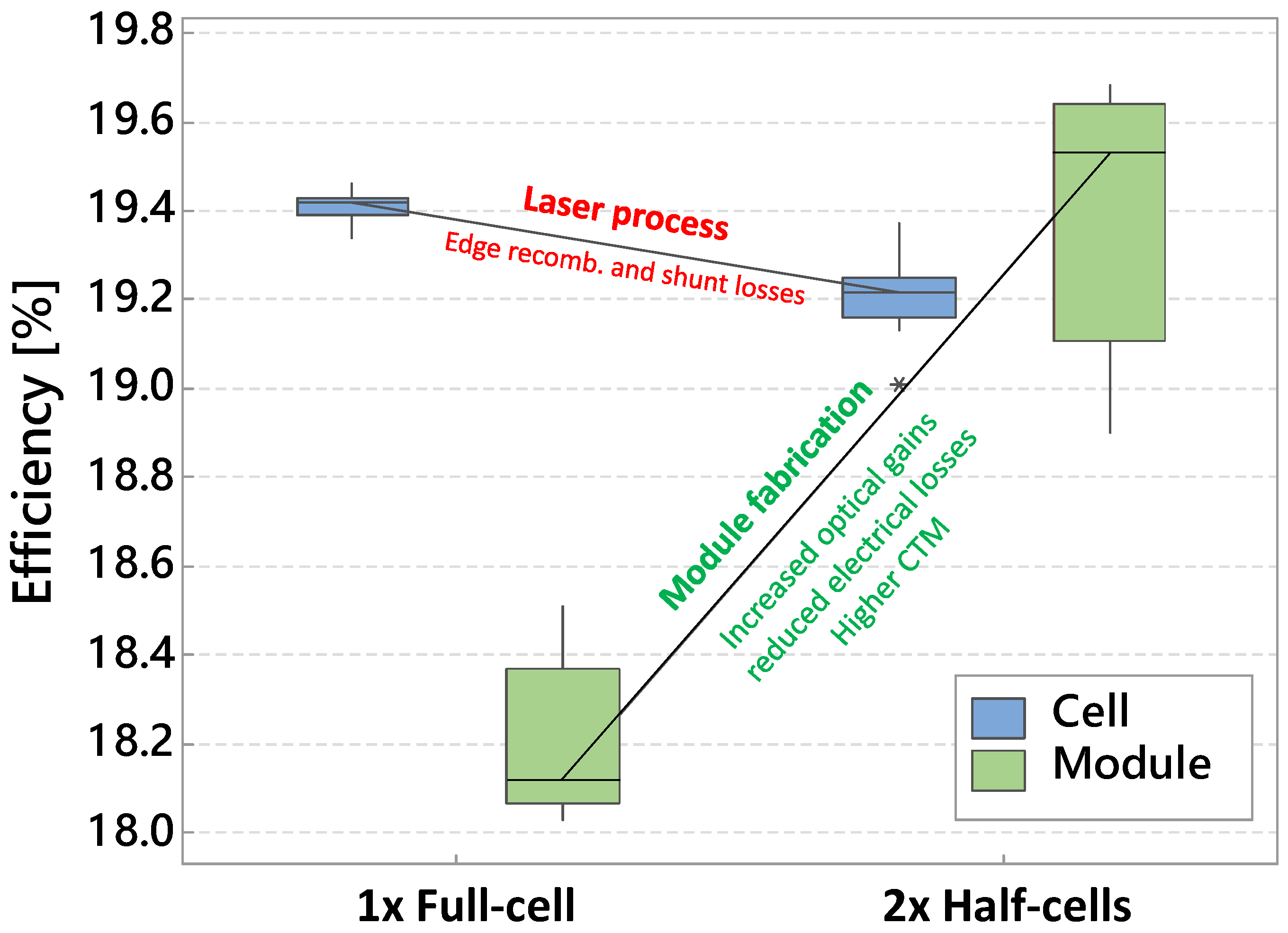

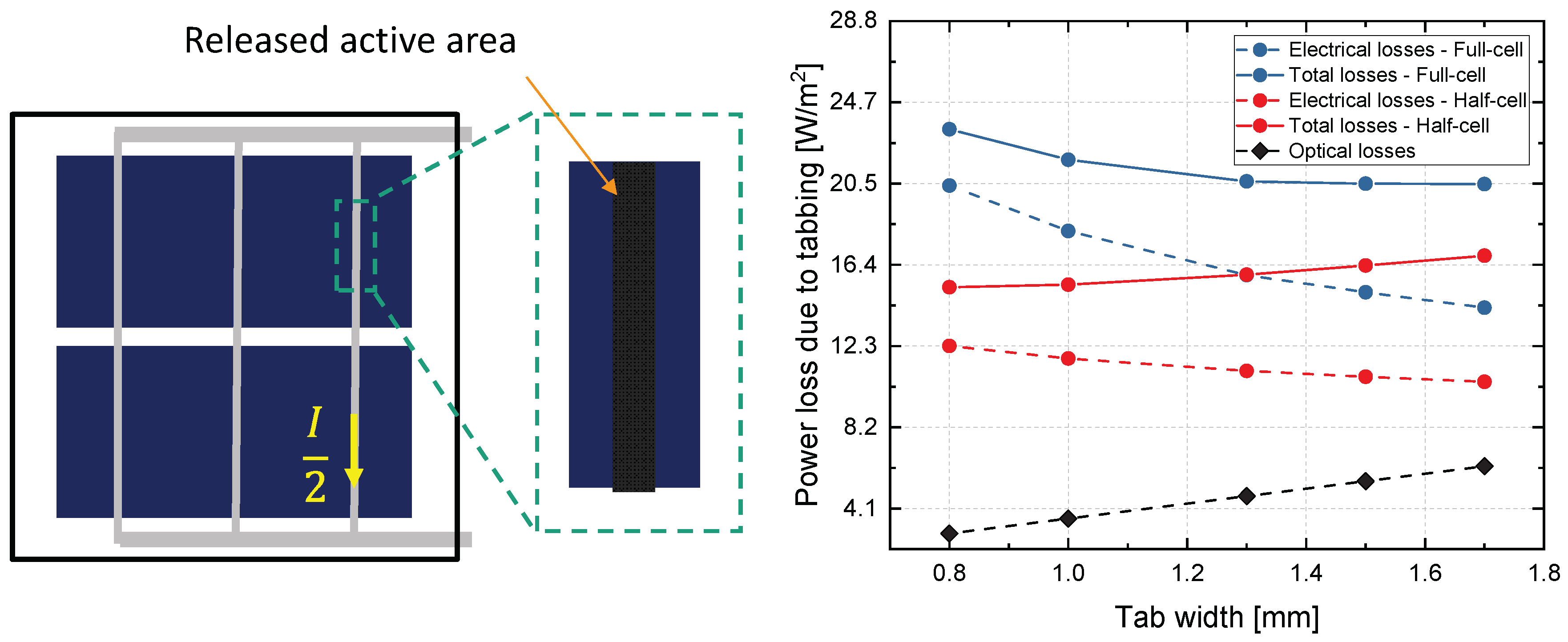
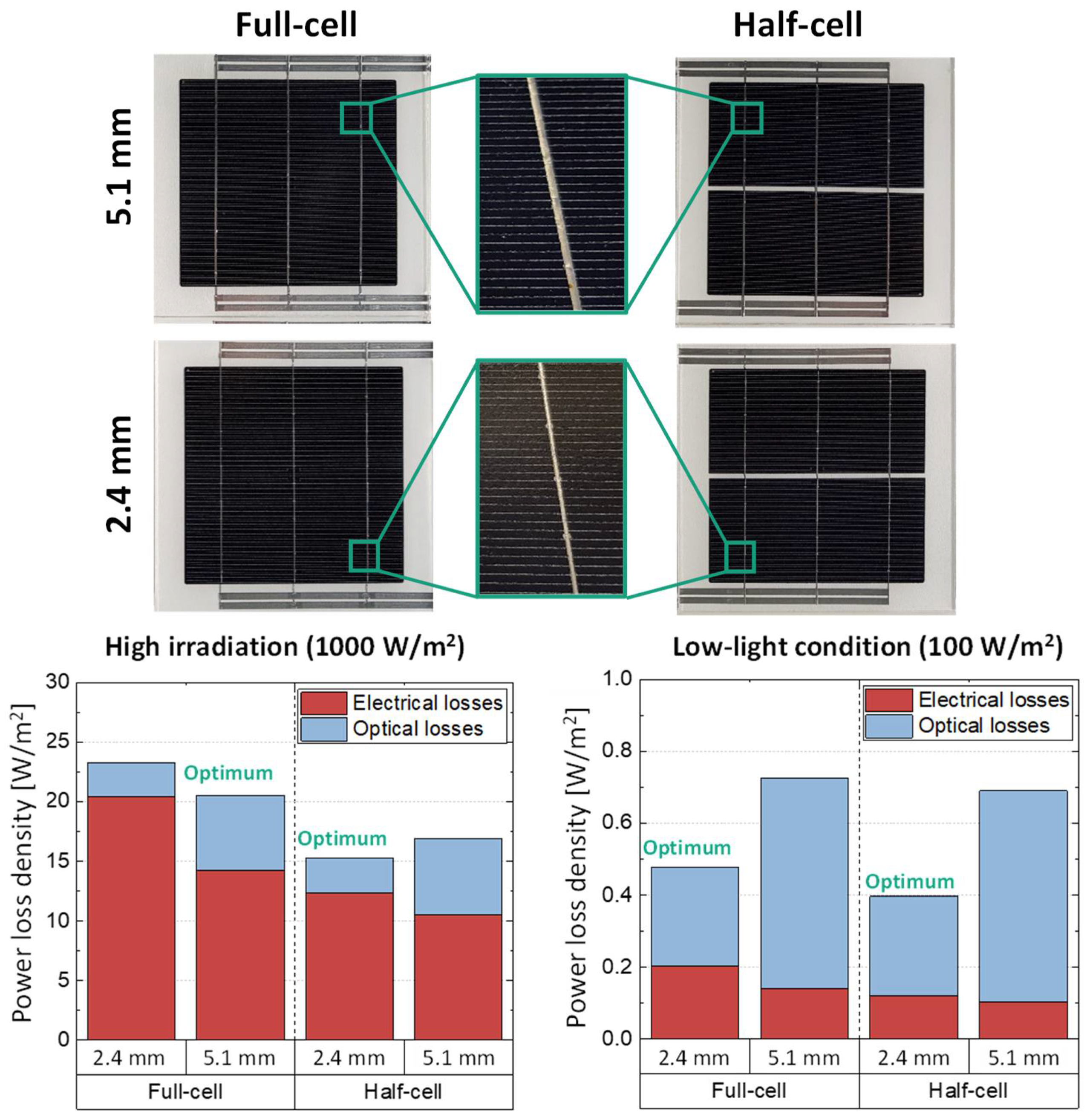
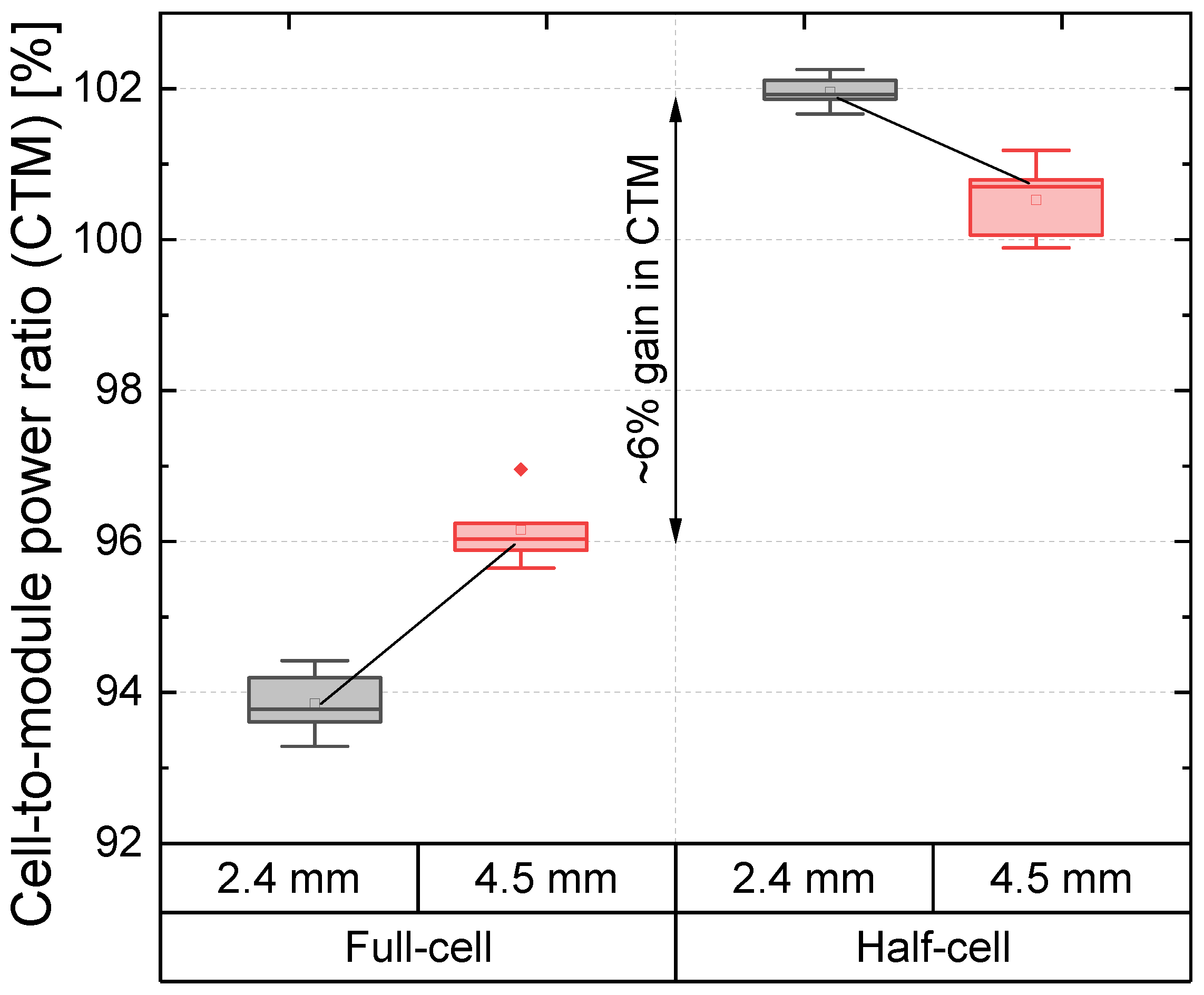

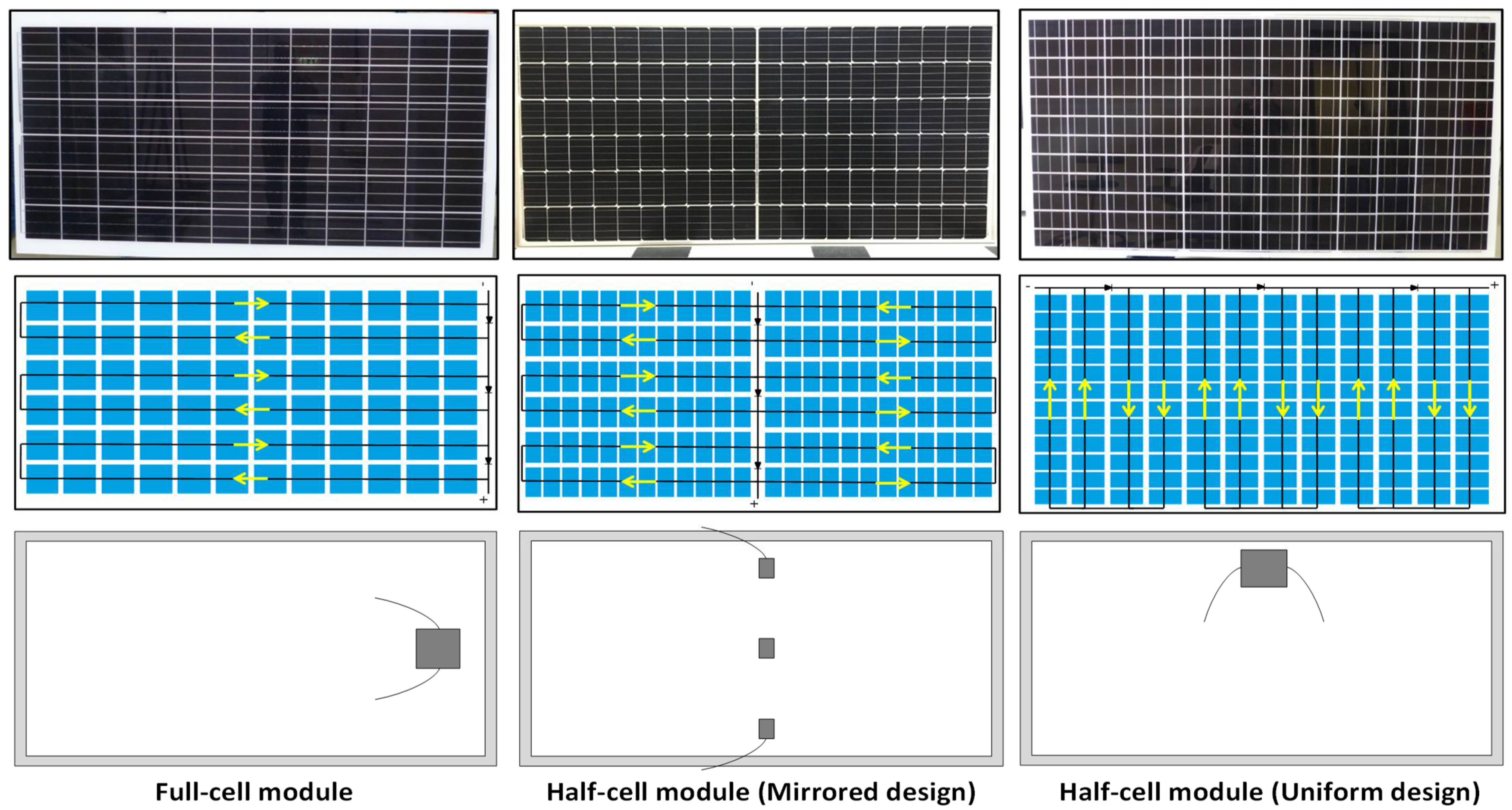
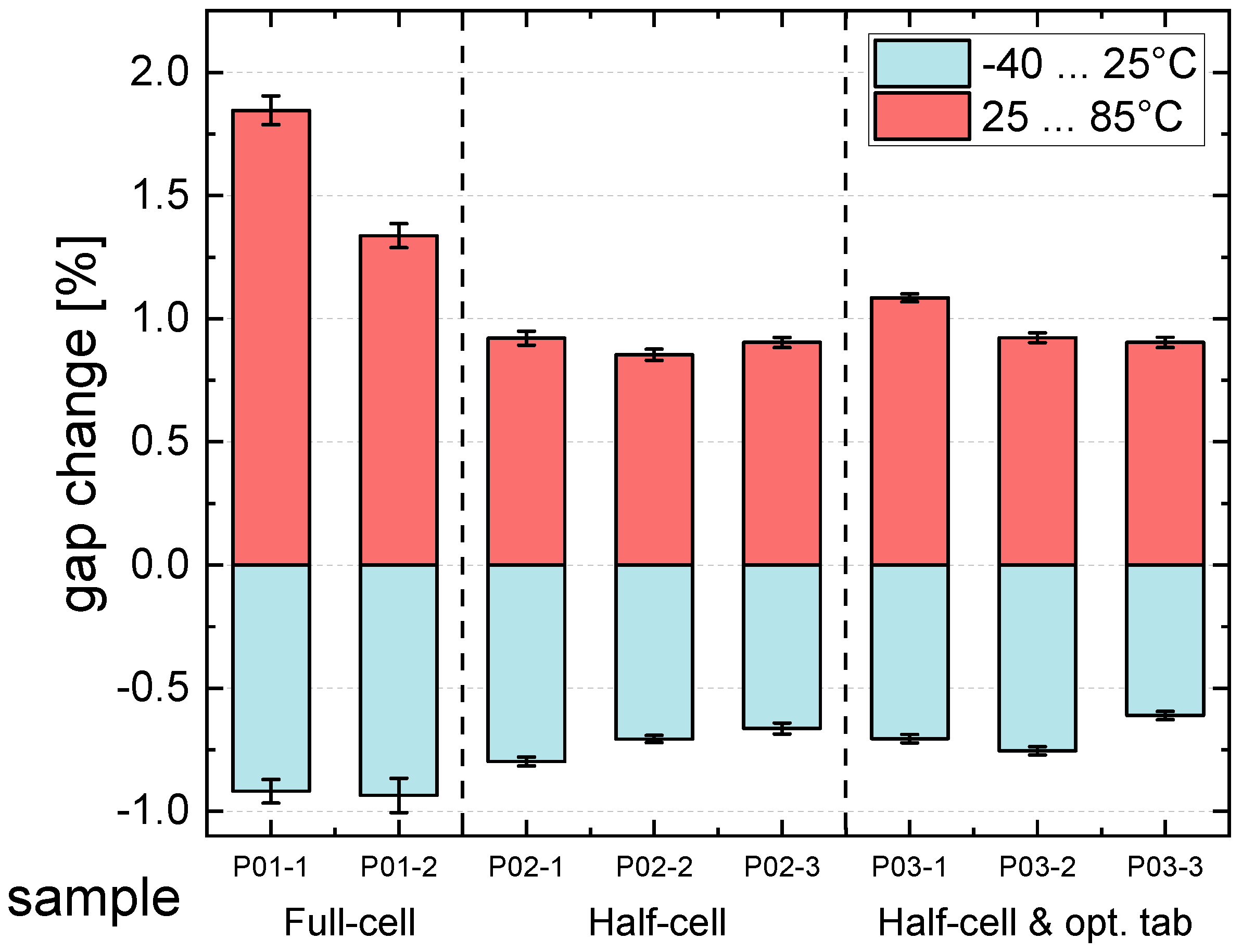
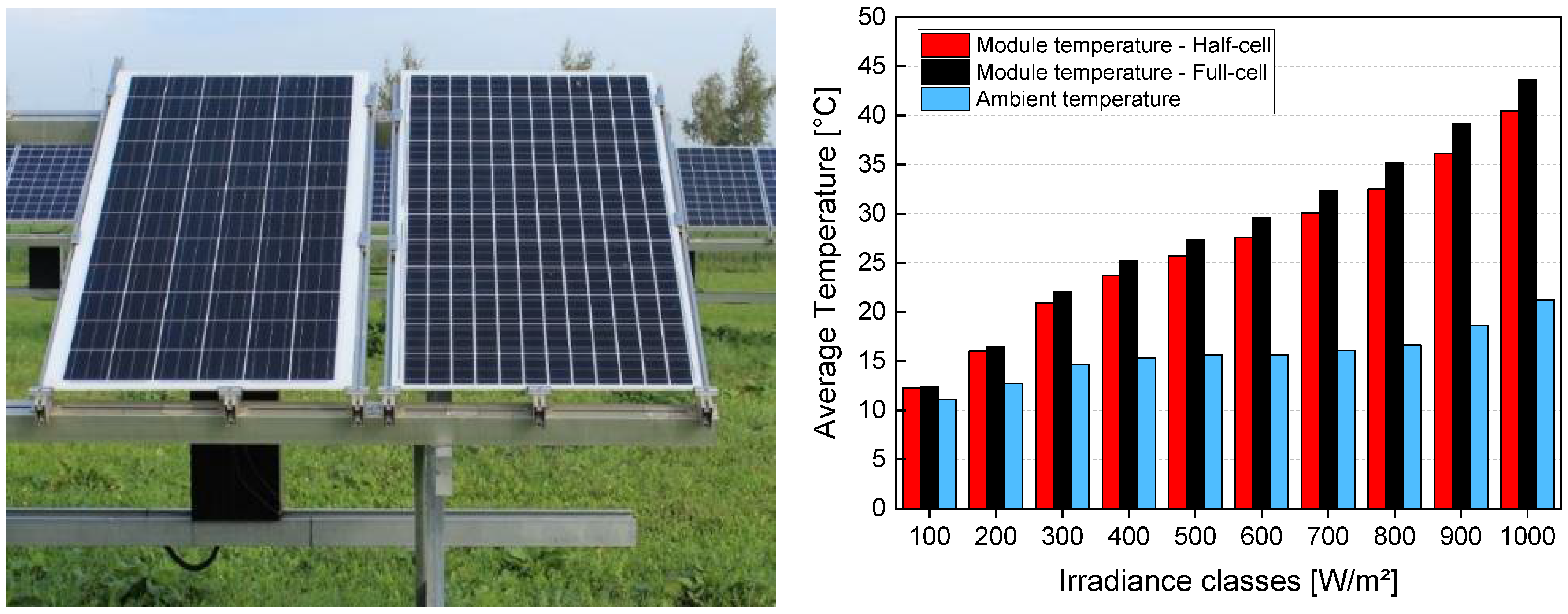


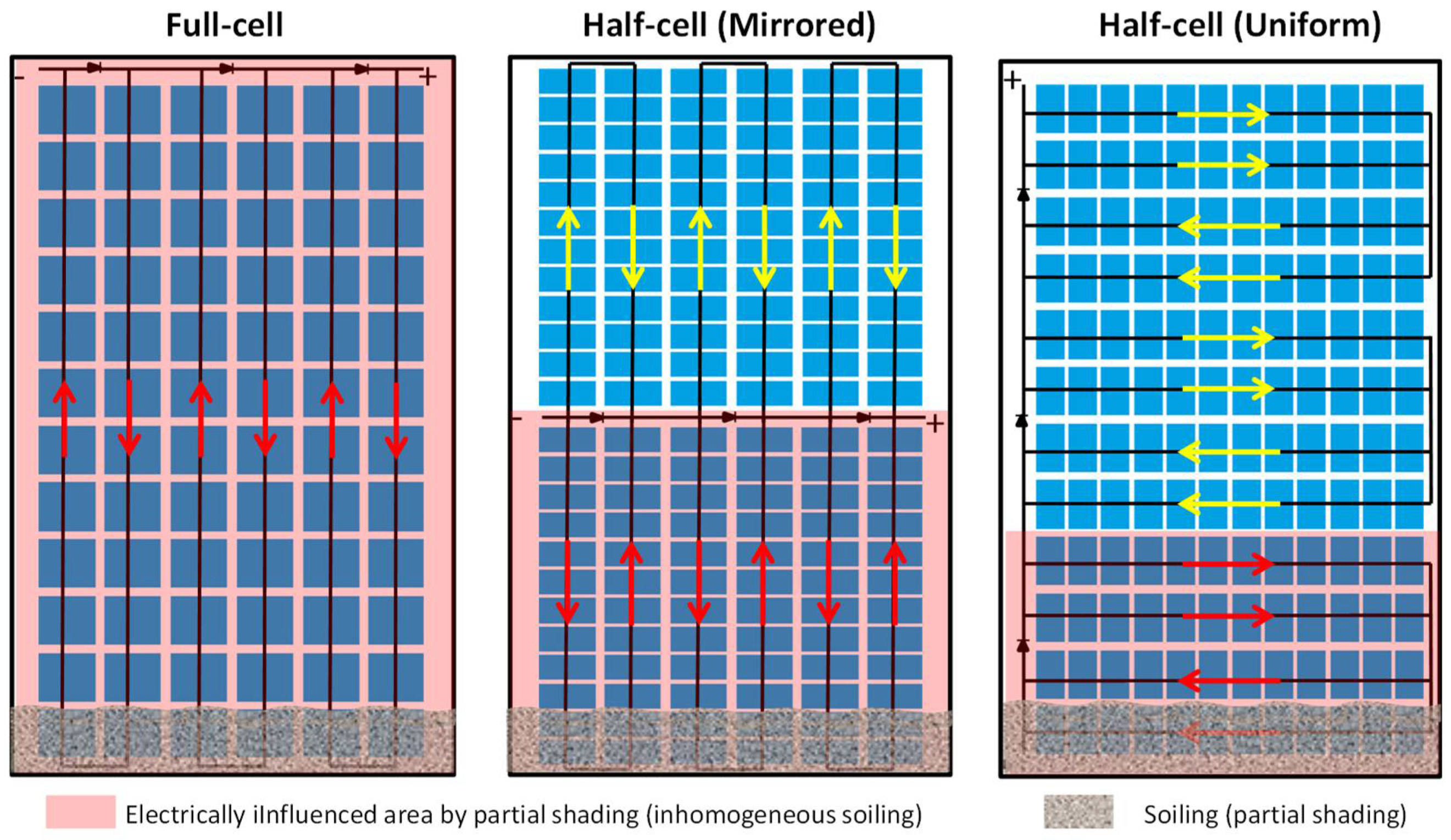
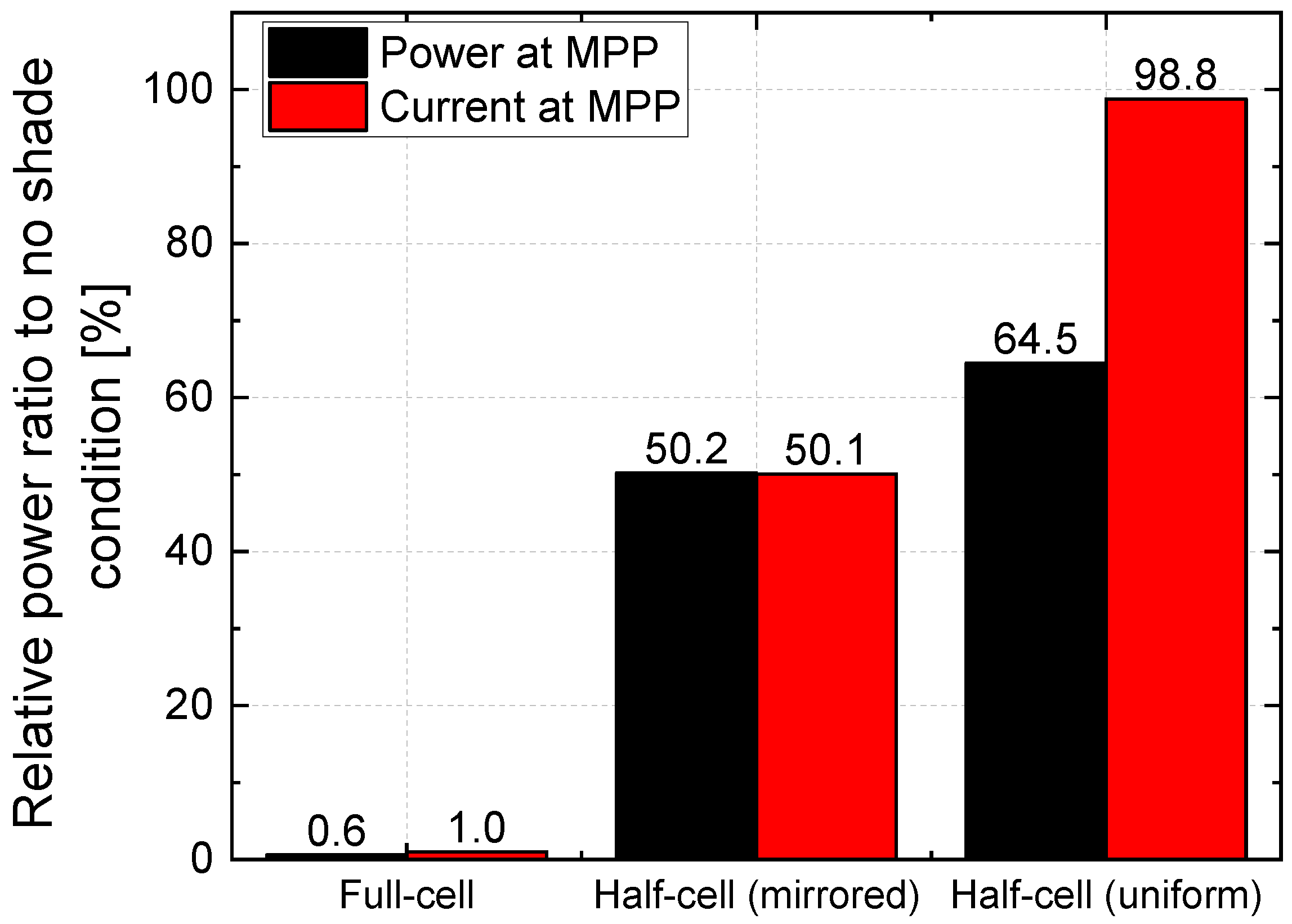
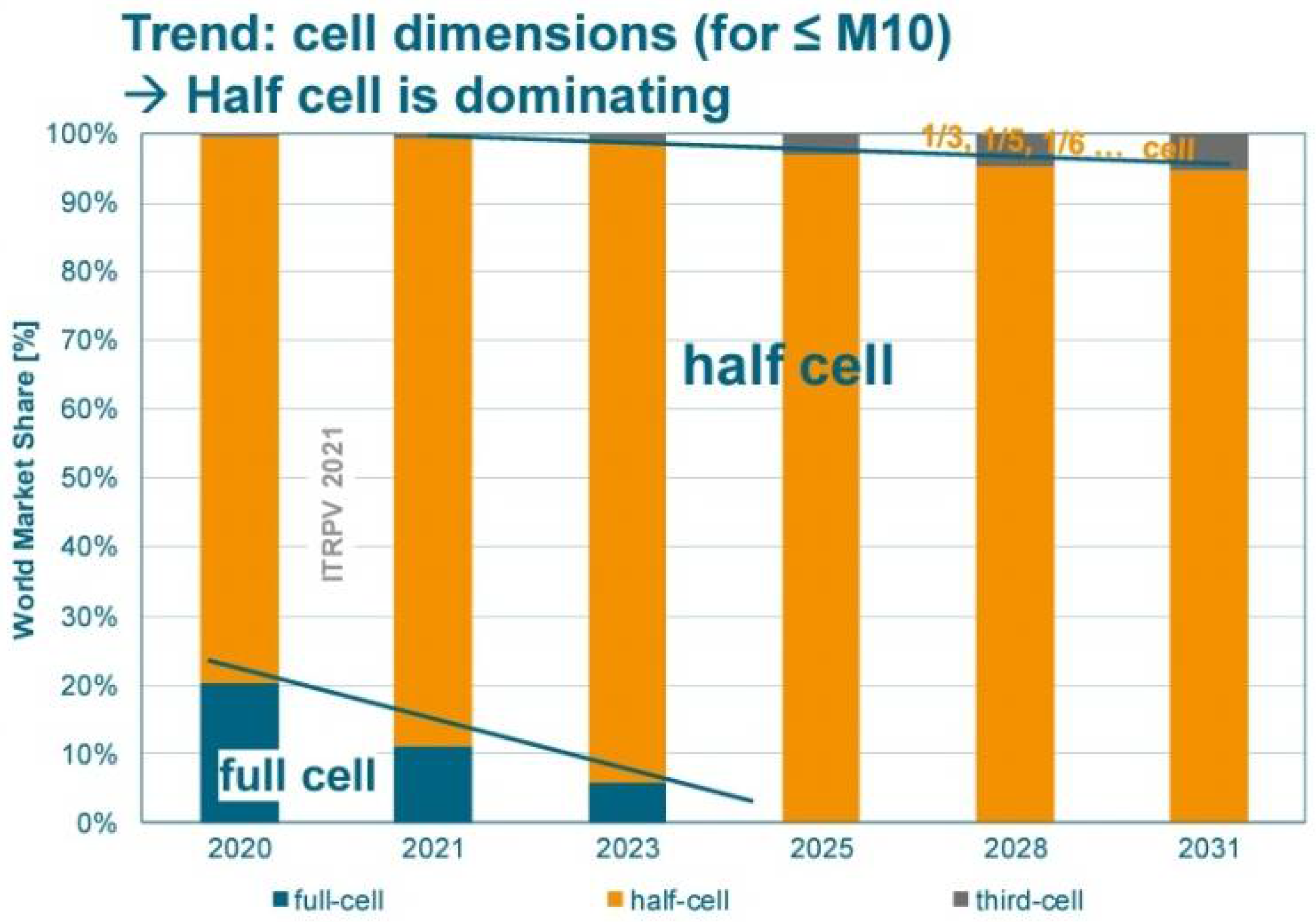
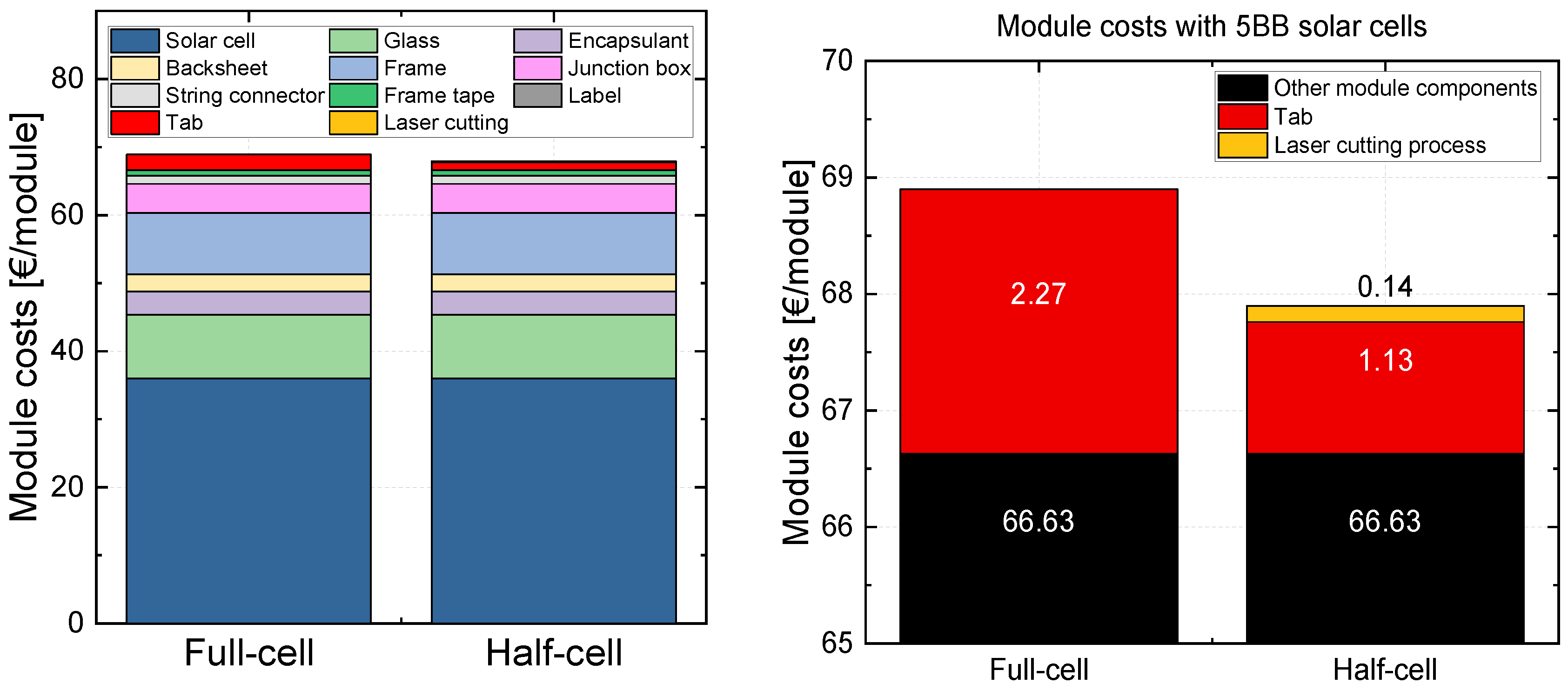

| Type | Length [mm] | Width [mm] | Area [cm2] | ISC [A] | ISC-Full-cell [A] | ISC-Half-cell [A] | ISC-Third-cell [A] |
|---|---|---|---|---|---|---|---|
| M1 | 156 | 156 | 243.4 | 9.3 | 9.3 | 4.7 | 3.1 |
| M2 | 156.75 | 156.75 | 245.7 | 9.4 | 9.4 | 4.7 | 3.1 |
| M3 | 158.75 | 158.75 | 252.0 | 9.6 | 9.6 | 4.8 | 3.2 |
| M4 | 161.7 | 161.7 | 261.5 | 10.0 | 10.0 | 5.0 | 3.3 |
| M5 | 165 | 165 | 272.3 | 10.4 | 10.4 | 5.2 | 3.5 |
| M6 | 66 | 66 | 275.6 | 10.5 | 10.5 | 5.3 | 3.5 |
| M10 | 182 | 182 | 331.2 | 12.7 | 12.7 | 6.3 | 4.2 |
| M12 | 210 | 210 | 441.0 | 16.9 | 16.9 | 8.4 | 5.6 |
| Specification of the Splitting Device | |
|---|---|
| Laser machine life span | 10 years |
| Laser unit time span | 5 years |
| Electricity consumption | 3 kW |
| Cutting speed | 1 cut/s |
| Breakage rate | 0.1% |
| Total cuts per year | 31,504,464 |
| Factory capacity | |
| Solar cell power | 5 W |
| Yearly factory capacity | 157.52 MW |
| Total costs per year (for 10 years) | |
| Laser machine | 300,000 EUR |
| Laser unit | 1000 EUR |
| Electricity | 7776 EUR |
| Maintenance | 3000 EUR |
| Labor | 31,200 EUR |
| Specification of the Splitting Device | |
|---|---|
| Laser machine life span | 10 years |
| Laser unit time span | 5 years |
| Electricity consumption | 3 kW |
| Cutting speed | 1 cut/s |
| Breakage rate | 0.1% |
| Total cuts per year | 31,504,464 |
| Factory capacity | |
| Solar cell power | 5 W |
| Yearly factory capacity | 157.52 MW |
| Total costs per year (for 10 years) | |
| Laser machine | 300,000 EUR |
| Laser unit | 1000 EUR |
| Electricity | 7776 EUR |
| Maintenance | 3000 EUR |
| Labor | 31,200 EUR |
Publisher’s Note: MDPI stays neutral with regard to jurisdictional claims in published maps and institutional affiliations. |
© 2022 by the authors. Licensee MDPI, Basel, Switzerland. This article is an open access article distributed under the terms and conditions of the Creative Commons Attribution (CC BY) license (https://creativecommons.org/licenses/by/4.0/).
Share and Cite
Hanifi, H.; Jaeckel, B.; Pander, M.; Dassler, D.; Kumar, S.; Schneider, J. Techno-Economic Assessment of Half-Cell Modules for Desert Climates: An Overview on Power, Performance, Durability and Costs. Energies 2022, 15, 3219. https://doi.org/10.3390/en15093219
Hanifi H, Jaeckel B, Pander M, Dassler D, Kumar S, Schneider J. Techno-Economic Assessment of Half-Cell Modules for Desert Climates: An Overview on Power, Performance, Durability and Costs. Energies. 2022; 15(9):3219. https://doi.org/10.3390/en15093219
Chicago/Turabian StyleHanifi, Hamed, Bengt Jaeckel, Matthias Pander, David Dassler, Sagarika Kumar, and Jens Schneider. 2022. "Techno-Economic Assessment of Half-Cell Modules for Desert Climates: An Overview on Power, Performance, Durability and Costs" Energies 15, no. 9: 3219. https://doi.org/10.3390/en15093219
APA StyleHanifi, H., Jaeckel, B., Pander, M., Dassler, D., Kumar, S., & Schneider, J. (2022). Techno-Economic Assessment of Half-Cell Modules for Desert Climates: An Overview on Power, Performance, Durability and Costs. Energies, 15(9), 3219. https://doi.org/10.3390/en15093219








